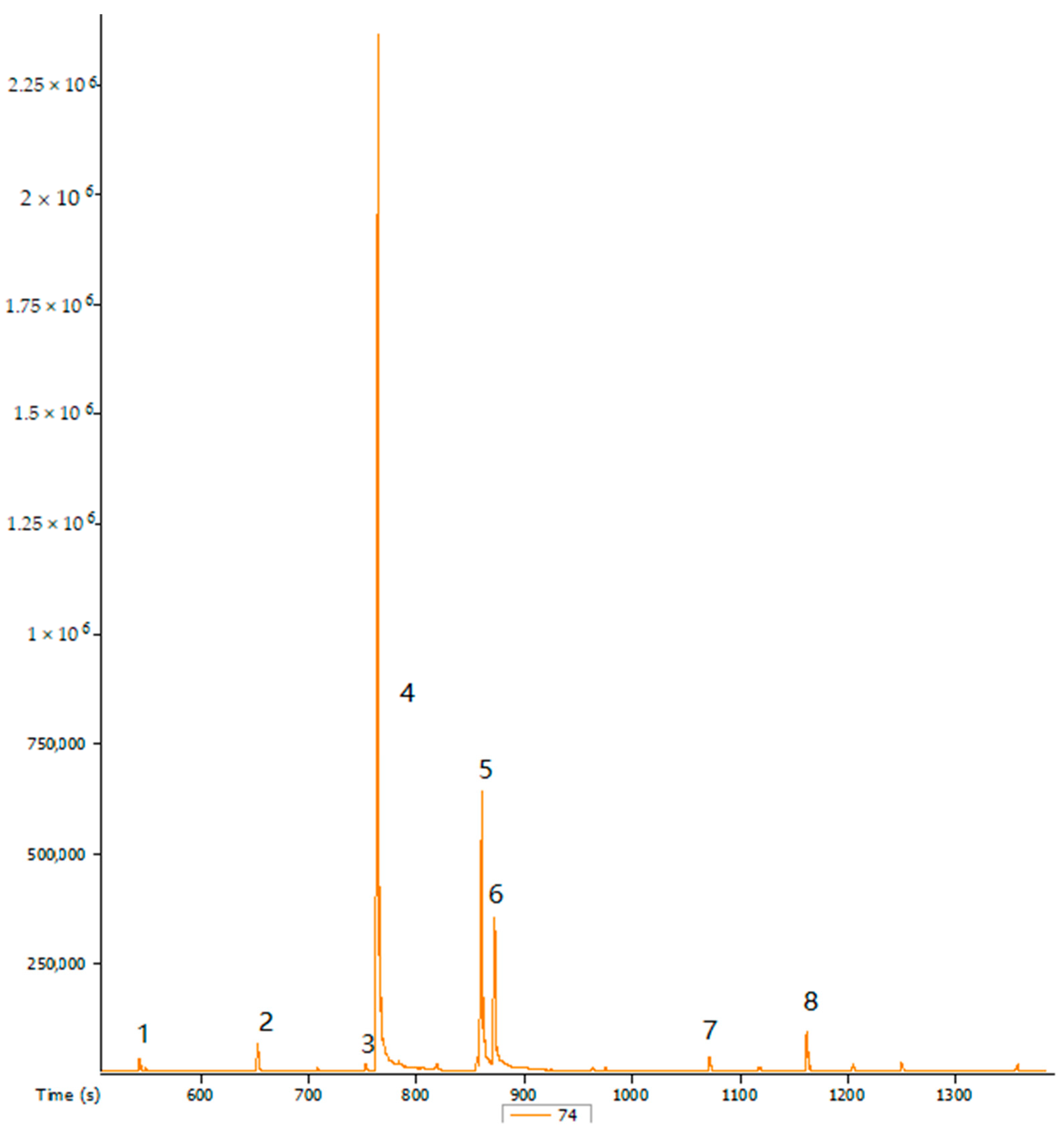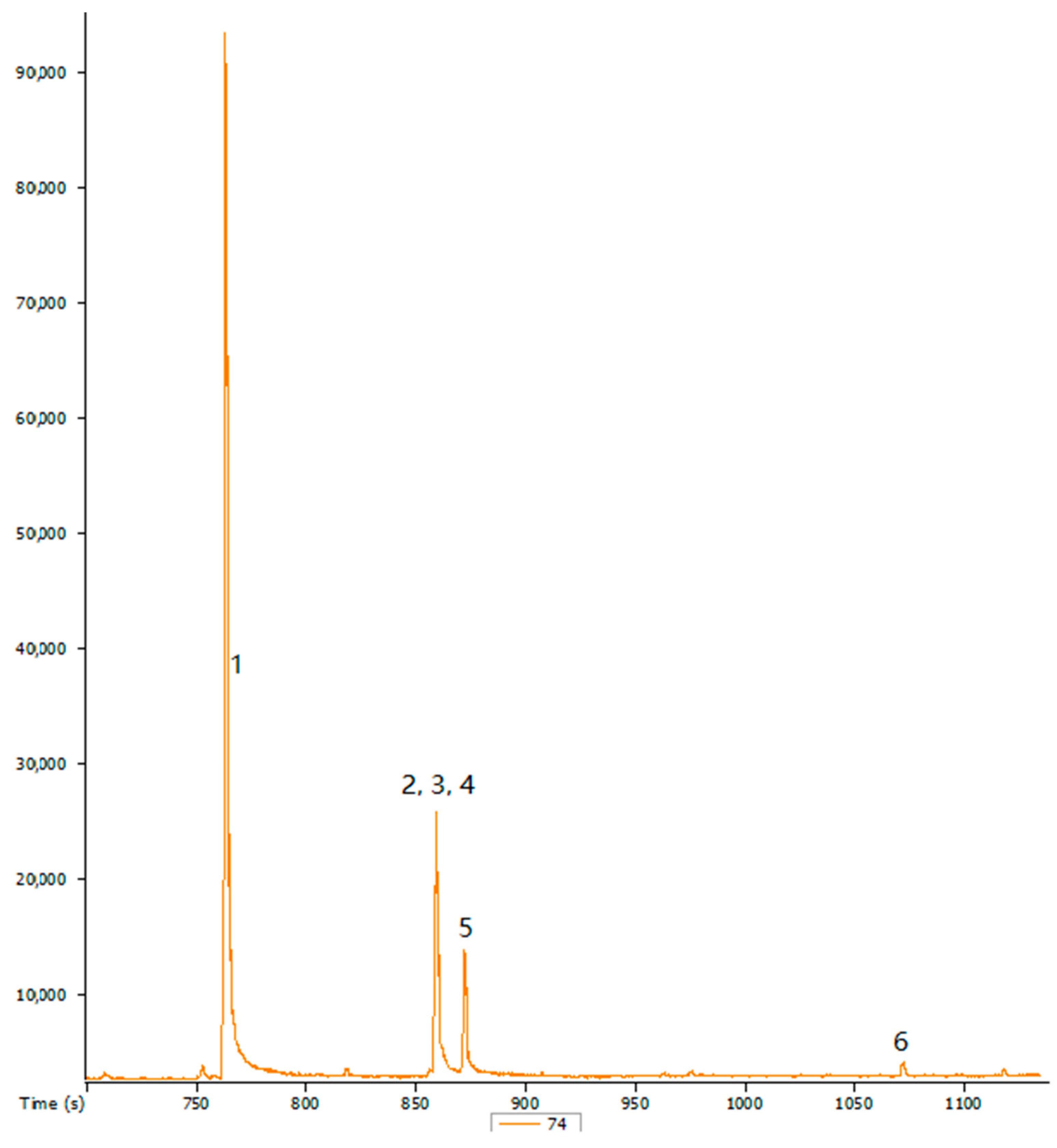Fatty Acid Composition of Dried Fruits of Sclerocarya birrea, Diospyros blancoi and Landolphia kirkii
Abstract
:1. Introduction
2. Materials and Methods
2.1. Sampling and Storage
2.2. Chemicals and Reagents
2.3. Preparation of Fruits
2.4. Fatty Acid Compositions
2.4.1. Extraction of Oils
2.4.2. GC-TOF-MS Analysis of Fatty Acid Methyl Ester
2.5. Data Analysis
3. Results
3.1. Fatty Acid Composition of D. blancoi, S. birrea and L. kirkii
3.2. Effect of Maturity on Fatty Acid Composition in S. birrea Fruit Parts
4. Discussion
4.1. Fatty Acid Composition of D. blancoi, S. birrea and L. kirkii
4.2. Effect of Maturity on Fatty Acid Composition in S. birrea
5. Conclusions
Acknowledgments
Author Contributions
Conflicts of Interest
References
- Agudo, A. Measuring intake of fruits and vegetables. In Joint FAO/WHO Workshop on Fruits and Vegetables for Health, 1–3 Septermber 2004, Kobe, Japan; World Health Organization: Geneve, Switzerland, 2004; p. 40. [Google Scholar]
- Stadlmayr, B.; Ruth, U.; Kehlenbeck, K. Nutrient composition of selected indigenous fruits from sub-Saharan Africa. J. Sci. Food Agric. 2013, 93, 2627–2636. [Google Scholar] [CrossRef] [PubMed]
- Sánchez-mata, M.C.; Cámara, M.; Morales, R.; Tardío, J. Wild edible fruits as a potential source of phytochemicals with capacity to inhibit lipid peroxidation. Eur. J. Lipid. Sci. Technol. 2013, 4, 1–32. [Google Scholar]
- Tolonen, M. Vitamins and Minerals in Health and Nutrition; Ellis Horwood Limited: Abington, MA, USA, 1990. [Google Scholar]
- FAO Fats and Fatty Acids in Human Nutrition. Report of an Expert Consultation; Food and Agriculture Organization of the United Nations: Rome, Italy, 2008; Volume 91, ISBN 978-9-25-106733-8. [Google Scholar]
- Wei, A.; Shibamoto, T. Medicinal Activities of Essential Oils: Role in Disease Prevention, 1st ed.; Elsevier Inc.: Amsterdam, The Netherlands, 2010; ISBN 978-0-12-374628-3. [Google Scholar]
- Ogbobe, O. Physico-chemical composition and characterisation of the seed and seed oil of Sclerocarya birrea. Plant Foods Hum. Nutr. 1992, 42, 201–206. [Google Scholar] [CrossRef] [PubMed]
- Glew, R.; VanderJagt, D.; Huang, Y.; Chuang, L.; Bosse, R.; Glew, R. Nutritional analysis of the edible pit of Sclerocarya birrea in the Republic of Niger (daniya, Hausa). J. Food Compost. Anal. 2004, 17, 99–111. [Google Scholar] [CrossRef]
- Hiwilepo-van Hal, P.; Bille, P.G.; Verkerk, R.; van Boekel, M.A.J.S.; Dekker, M. A review of the proximate composition and nutritional value of Marula (Sclerocarya birrea subsp. caffra). Phytochem. Rev. 2014, 13, 881–892. [Google Scholar] [CrossRef]
- Chivandi, E.M.; Erlwanger, K.H.; Davidson, B.C. Lipid content and fatty acid profile of the fruit seeds of Diospyros mespiliformis. Int. J. Integr. Biol. 2009, 5, 121–124. [Google Scholar]
- Greenfield, H.; Southgate, D. Sampling, 2nd ed.; Burlingame, B., Charrondiere, U., Eds.; Food and Agriculture Organization of the United Nations: Rome, Italy, 2003; ISBN 978-1-4613-6573-0. [Google Scholar]
- Bogucka-Kocka, A.; Janyszek, M. Fatty acids composition of fruits of selected Central European sedges (Carex L. Cyperaceae). Grasas y Aceites 2010, 61, 165–170. [Google Scholar] [CrossRef]
- Connor, K.; Schaefer, G.; Donahoo, J.; Devall, M.; Gardiner, E.; Hawkins, T.; Wilson, D.; Schiff, N.; Hamel, P.; Leininger, T. Development, fatty acid composition, and storage of drupes and seeds from the endangered pondberry (Lindera melissifolia). Biol. Conserv. 2007, 137, 489–496. [Google Scholar] [CrossRef]
- Blasa, M.; Gennari, L.; Angelino, D.; Ninfali, P. Fruit and Vegetable Antioxidants in Health, 1st ed.; Elsevier Inc.: Amsterdam, The Netherlands, 2010; ISBN 978-0-12-374628-3. [Google Scholar]
- Mariod, A.A.; Abdelwahab, S.I. Sclerocarya birrea (Marula), An African Tree of Nutritional and Medicinal Uses: A Review. Food Rev. Int. 2012, 28, 375–388. [Google Scholar] [CrossRef]
- Darnet, S.H.; Da Silva, L.H.M.; Rodrigues, A.M.D.C.; Lins, R.T. Nutritional composition, fatty acid and tocopherol contents of buriti (Mauritia flexuosa) and patawa (Oenocarpus bataua) fruit pulp from the amazon region. Ciência e Tecnologia de Alimentos 2011, 31, 488–491. [Google Scholar] [CrossRef]
- Magaia, T.; Uamusse, A.; Sjöholm, I.; Skog, K. Proximate analysis of five wild fruits of mozambique. Sci. World J. 2013, 2013, 1–6. [Google Scholar] [CrossRef] [PubMed]
- Ojewole, J.A.O.; Mawoza, T.; Chiwororo, W.D.H.; Owira, P.M.O. Sclerocarya birrea (A Rich) Hochst. [“Marula”] (Anacardiaceae): A review of its phytochemistry, pharmacology and toxicology and its ethnomedicinal uses. Phytother. Res. 2010, 24, 633–639. [Google Scholar] [CrossRef] [PubMed]
- Simopoulos, A.P. Omega-3 fatty acids in wild plants, nuts and seeds. Asia Pac. J. Clin. Nutr. 2002, 11, S163–S173. [Google Scholar] [CrossRef]
- Inoue, H.; Tateishi, A. Ripening and fatty acid composition of avocado fruit in Japan. In Proceedings of the World Avocado Congress III, Tel Aviv, Israel, 22–27 October 1995; World Avocardo Congress Proceedings: Oakland, CA, USA, 1995; pp. 366–369. [Google Scholar]
- Aidi Wannes, W.; Mhamdi, B.; Marzouk, B. Variations in essential oil and fatty acid composition during Myrtus communis var. italica fruit maturation. Food Chem. 2009, 112, 621–626. [Google Scholar] [CrossRef]
- Msaada, K.; Hosni, K.; Ben Taarit, M.; Chahed, T.; Hammami, M.; Marzouk, B. Changes in fatty acid composition of coriander (Coriandrum sativum L.) fruit during maturation. Ind. Crops Prod. 2009, 29, 269–274. [Google Scholar] [CrossRef]
- Villa-Rodríguez, J.A.; Molina-Corral, F.J.; Ayala-Zavala, J.F.; Olivas, G.I.; González-Aguilar, G.A. Effect of maturity stage on the content of fatty acids and antioxidant activity of “Hass” avocado. Food Res. Int. 2011, 44, 1231–1237. [Google Scholar] [CrossRef]
- Vinceti, B.; Ickowitz, A.; Powell, B.; Kehlenbeck, K.; Termote, C.; Cogill, B.; Hunter, D. The contributions of forest foods to sustainable diets. Unasylva 2013, 64, 54–64. [Google Scholar]
- Hwalla, N.; El Khery, D.T.D. Lebanese Traditional Diets and Health Effects. In Wild-Type Food in Health Promotion and Disease Prevention: The Columbus Concept; DeMeester, F., Watson, R., Eds.; Humana Press Inc: Totowa, NJ, USA, 2008; pp. 493–497. ISBN 1597453307. [Google Scholar]
- Tavakoli, J.; Khodaparast, M.H.H. Evaluating the fatty acid composition of the oil from fruit hulls of two Pistacia species growing wild in Iran. Chem. Nat. Compd. 2013, 49, 83–84. [Google Scholar] [CrossRef]
- Yu, L.; Parry, J.W.; Zhou, K. Oils from herbs, spices, and fruit seeds. In Bailey’s Industrial Oil and Fat Products; Shahidi, F., Ed.; John Wiley & Sons, Inc.: Hoboken, NJ, USA, 2005; pp. 233–258. [Google Scholar]


| Fatty Acid | DbF | DbP | DbS |
|---|---|---|---|
| Nonanoic acid (C9:0) | - | - | 23.13 |
| Hexadecanoic acid (C16:0) | - | 62.05 | 46.31 |
| Octadecanoic acid (C18:0) | 100 | 24.71 | - |
| 9-Octadecenoic (C18:1n-9) | - | 8.92 | 8.22 |
| 9,12-Octadecadienoic (C18:2n-6) | - | - | 22.34 |
| Octadecadieonic acid (C18:2n-4) | - | 4.32 | - |
| Total | 100 | 100 | 100 |
| Fatty Acid | SbSR | SbSOR | SbPR | SbPOR |
|---|---|---|---|---|
| Nonanoic acid (C9:0) | 0.29 | 2.45 | - | 7.14 |
| Dodecanoic acid (C12:0) | - | - | 0.27 | - |
| Tridecanoic acid (C13:0) | - | 5.12 | - | - |
| Tetradecanoic acid (C14:0) | - | - | 2.16 | - |
| Hexadecanoic acid (C16:0) | 71.31 | 55.92 | 67.03 | 68.34 |
| Palmitoleic acid (C16:1n-7) | 1.23 | 3.01 | 0.66 | - |
| 7-Hexadecenoic acid (C16:1n-9) | - | - | 0.66 | - |
| Hexadecatrieonic acid (C16:3n-3) | - | - | - | 7.70 |
| Octadecanoic acid (C18:0) | 17.0 | 12.70 | 9.11 | - |
| 9-Octadecenoic (C18:1n-9) | 5.33 | 12.97 | 18.82 | 15.35 |
| 9,-12-Octadecadienoic (C18:2n-6) | 4.85 | - | 0.24 | 1.46 |
| 9,-12,-15-Octadecatrienoic acid (C18:3n-3) | - | 2.79 | - | - |
| Eicosadienoic acid (C20:2n-6) | - | 1.93 | - | - |
| Tetracosanoic acid (24:0) | - | - | 1.62 | - |
| Hexacosanoic acid (C26:0) | - | - | 0.40 | - |
| Octacosanoic acid (C28:0) | - | - | 0.37 | - |
| Cyclo fatty acids | - | 0.76 | - | - |
| Total | 100 | 97.65 | 99.91 | 99.99 |
| Fatty Acid | LkF | LkP | LkS |
|---|---|---|---|
| Tetradecanoic acid (C14:0) | - | - | 6.05 |
| Hexadecanoic acid (C16:0) | 57.73 | 58.40 | 73.55 |
| Octadecanoic acid (C18:0) | 31.03 | 41.60 | - |
| 9-Octadecenoic (C18:1n-9) | 3.84 | - | 8.63 |
| 9,-12-Octadecadienoic (C18:2n-6) | 6.23 | - | - |
| 9,-12,-15-Octadecatrienoic acid (C18:3n-3) | - | - | 3.51 |
| Octadecadieonic acid (C18:2n-4) | - | - | 4.96 |
| Cyclo fatty acids | 1.17 | - | 3.31 |
| Total | 100 | 100 | 100 |
© 2017 by the authors. Licensee MDPI, Basel, Switzerland. This article is an open access article distributed under the terms and conditions of the Creative Commons Attribution (CC BY) license (http://creativecommons.org/licenses/by/4.0/).
Share and Cite
Matemu, A.O.; Adeyemi, D.; Nyoni, H.; Mdee, L.; Tshabalala, P.; Mamba, B.; Msagati, T.A.M. Fatty Acid Composition of Dried Fruits of Sclerocarya birrea, Diospyros blancoi and Landolphia kirkii. Int. J. Environ. Res. Public Health 2017, 14, 1401. https://doi.org/10.3390/ijerph14111401
Matemu AO, Adeyemi D, Nyoni H, Mdee L, Tshabalala P, Mamba B, Msagati TAM. Fatty Acid Composition of Dried Fruits of Sclerocarya birrea, Diospyros blancoi and Landolphia kirkii. International Journal of Environmental Research and Public Health. 2017; 14(11):1401. https://doi.org/10.3390/ijerph14111401
Chicago/Turabian StyleMatemu, Athanasia O., Durotoye Adeyemi, Hlengilizwe Nyoni, Ladislaus Mdee, Papiso Tshabalala, Bhekie Mamba, and Titus A. M. Msagati. 2017. "Fatty Acid Composition of Dried Fruits of Sclerocarya birrea, Diospyros blancoi and Landolphia kirkii" International Journal of Environmental Research and Public Health 14, no. 11: 1401. https://doi.org/10.3390/ijerph14111401





